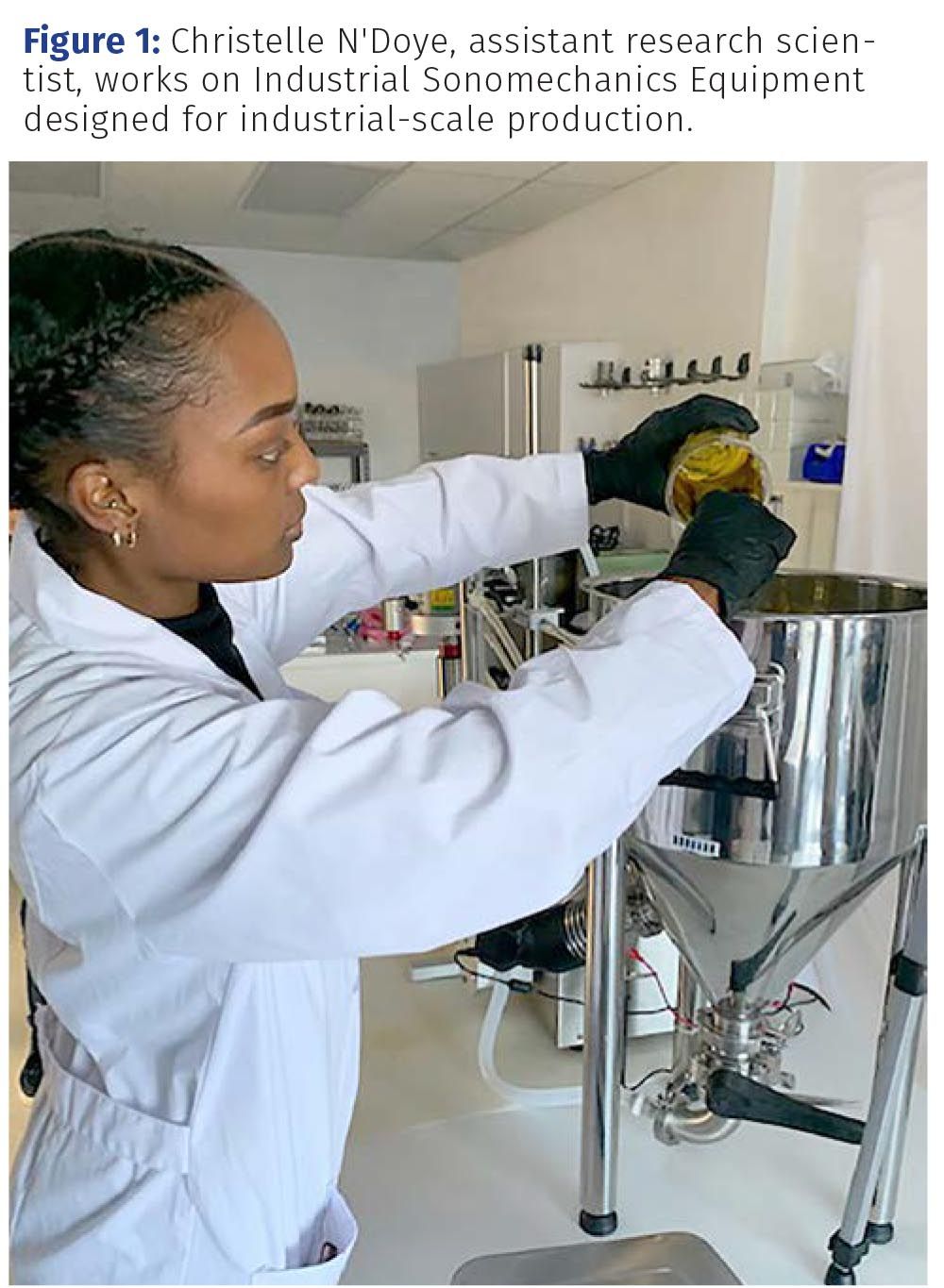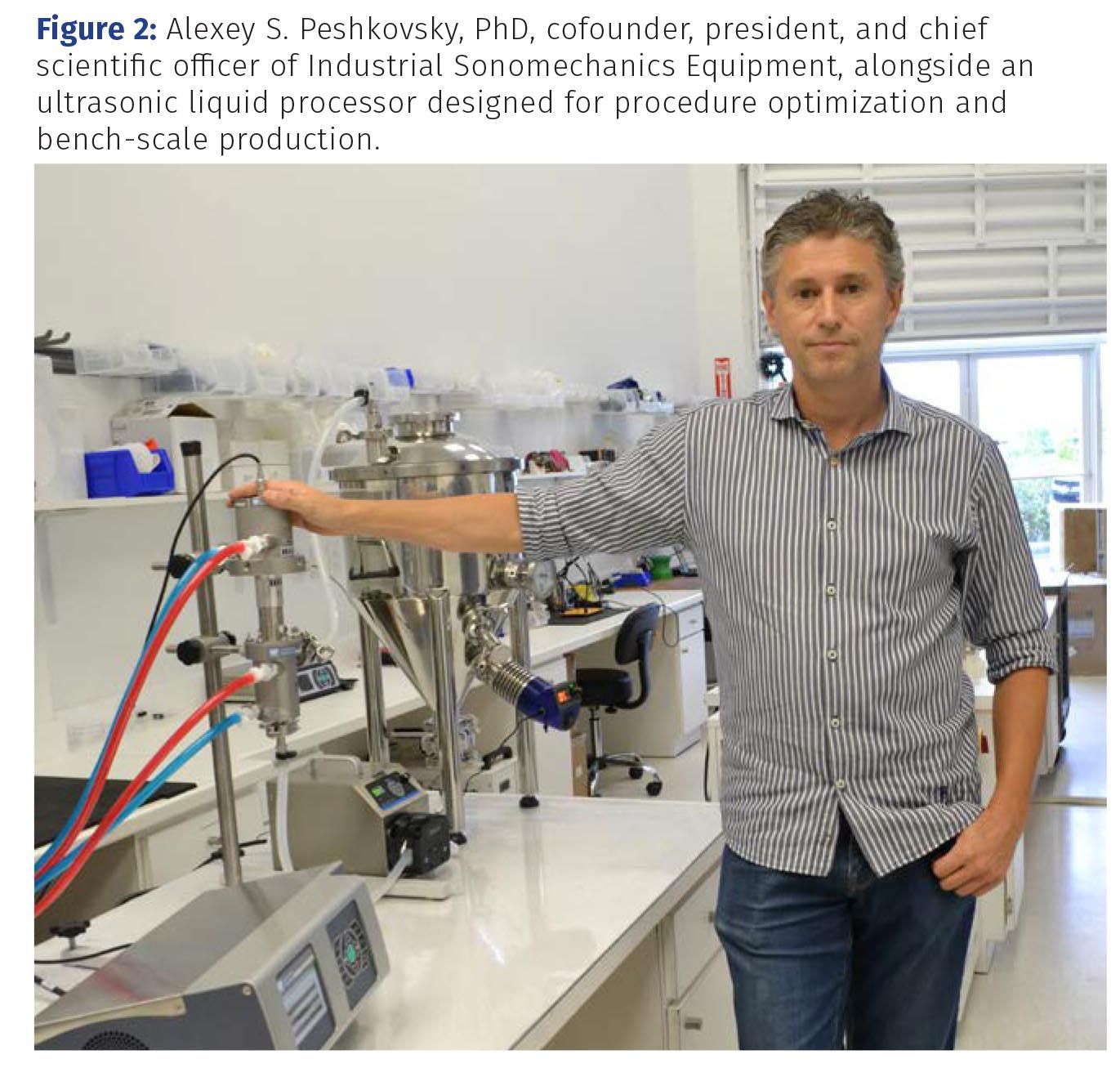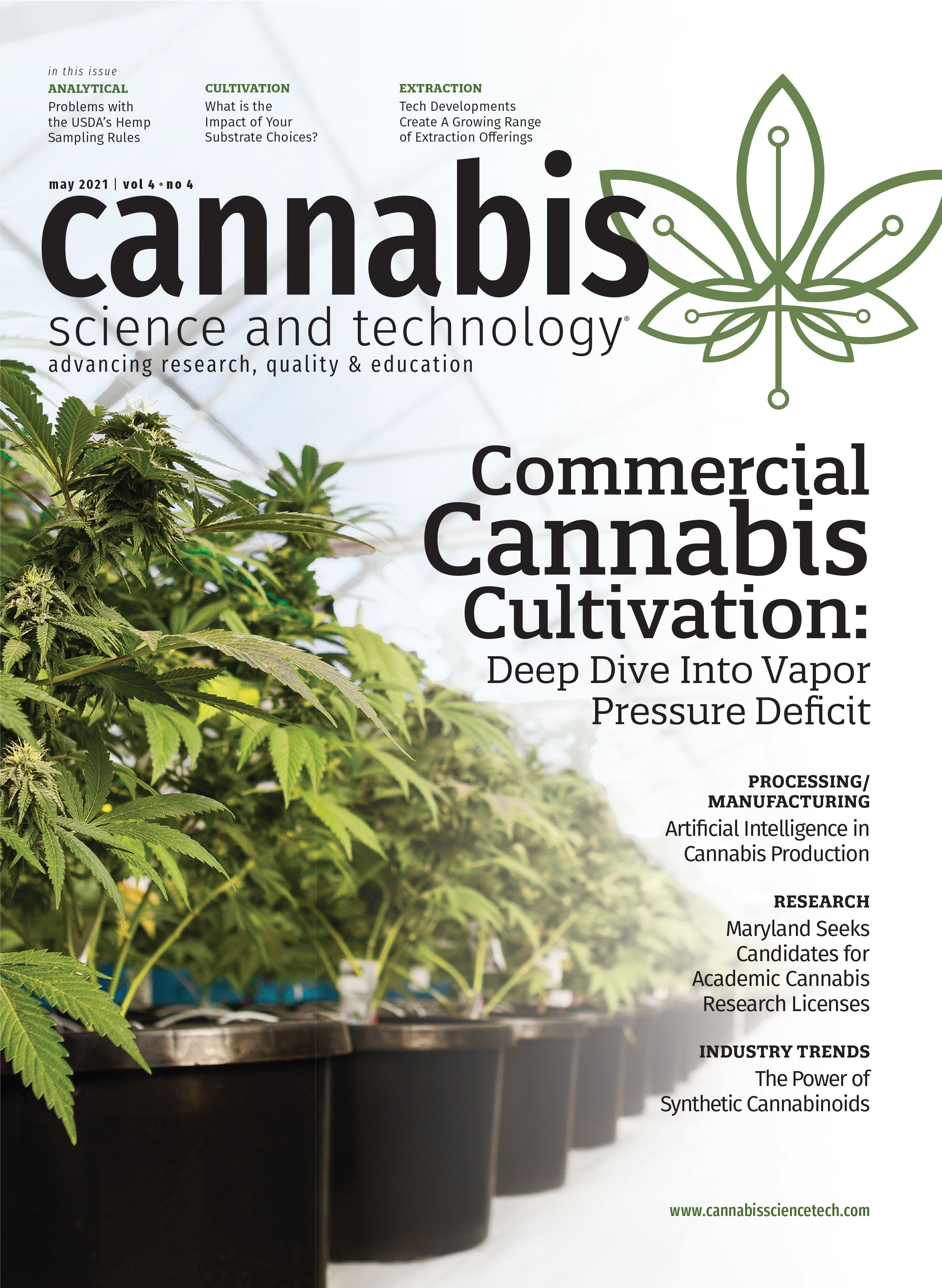Better Gear, More Precise Processes Help Propel A Growing Range of Extraction Offerings
An exploration on what is driving more focus on extraction technology for cannabis, and the work being done to find solutions to certain issues that need to be addressed in extraction.
Ultrasonic processing, triple fractionation, and cannabinoids created without cannabis are just a few of the tech developments being explored.
Anyone following trends in the maturing cannabis industry can instantly see how products based on extractions—oils, edibles, vapes, infusions, and more—are becoming the biggest and most popular sellers.
In this “Tech Innovations” column, we explore what is driving more focus on extraction technology for cannabis, and the work being done to find solutions to certain issues that need to be addressed in extraction work, including bioavailability.
According to an industry data and research organization (1), annual legal sales of cannabis are projected to reach more than $41 billion by 2025, and feature strong demand for value-added products (that is, vapes, concentrates, edibles, and topicals) which have held their premium pricing better than flower.
Mining down into demographics, another industry report (2) found that Gen Z consumers consistently spend more on vapor pens than Baby Boomers. Gen Z consumers also increased their wallet share to vapor pens in 2020, whereas Baby Boomers drastically decreased theirs.
Edibles go the opposite way. Edible shares increased among Baby Boomers between 2019 and 2020, while it decreased among Gen Z consumers.
Cannabis consumers are becoming more interested in cannabis infused beverages as well, with purchases slowly ticking up through 2020 and into 2021 (3), in part because of a better tetrahydrocannabinol (THC) infusion process that, again, is related to new extraction technology about bioavailability.
“There is a trend towards extract dominance,” said Nick Tennant, founder and chief technology officer of Precision Extraction Solutions. “As we become more educated about multiple forms of ingesting cannabinoids, we see the trends shifting away from the consumption of flower. Flower is always going to have a place. The overall experience of that bud, the different colors and different aromas from that bud—it’s a very primal experience connecting us with something that the Earth made. But there is also a disruptive trend in that an extract has a more diverse ability to be consumed in multiple different ways.”
Target: Better Bioavailability
The evolution of extraction technology has been focused on better bioavailability of cannabinoids, and the elimination of less desirable and more harmful delivery methods such as smoking or vaping.
Other methods of delivery that help with the bioavailability of cannabinoids by circumventing metabolism (including sublingual, or below the tongue; transdermal patches; and topical sprays or creams) continue to be developed and are increasingly in demand by consumers.

The process for extracting oils from botanicals have a long history within the context of plant-derived medicine and supplement development (4). Using butane and propane became a preferred method of extraction for the cannabis industry early on.
One of the earliest closed-loop hydrocarbon extraction units for cannabis came from Extraction Tek Solutions in 2011. The company’s extraction system, the 1300, was able to do “about a kilo an hour,” according to Matthew Ellis, founder and CEO of Extraction Tek Solutions. “We got it peer-reviewed with an engineering service that allowed us to put it in use. It was one of the first licensable hydrocarbon units to do both butane and propane,” Ellis said.
Over the ensuing years, the company created both a mid-sized unit and a larger processing unit, addressing the challenges of hydrocarbon extraction. “The challenge is to be able to get the gas into the material and out of the material fast enough,” he said. “So being able to get 50 pounds or 100 pounds of gas in and out of the material is hard. That is one of the challenges we are facing. But we got some newer equipment we are working with and some newer pumps that allow us to do what we need to do.”
Newer systems are working on a wider array of products today. Orally ingested capsules containing THC derived through extraction also have their place on the menu of cannabis offerings. But that particular method of THC consumption creates lower bioavailability since it also requires processing in the gut, and requires a higher dose for the proper therapeutic effect, according to a research paper coauthored by Alexey Peshkovsky (4), cofounder, president, and chief scientific officer of Industrial Sonomechanics, a research and development, equipment design, and manufacturing company. The company specializes in scalable high intensity ultrasonic technology for liquid treatment, focusing on making nanoemulsions, nanocrystals, and liposomes for the pharmaceutical, cosmetic, medical cannabis, and food and beverage industries.

One better method of bioavailability is through this nanoemulsion process. According to Peshkovsky’s research, nanoemulsions are kinetically stable liquid-liquid dispersions of spherical droplets in which the dispersed phase droplet diameter is typically near or below 200 nm (a nanometer is 1 billionth of meter—a human hair is about 60,000 nanometers [5]).
Such small droplets have very high surface area-to-volume ratios, which promotes high surface tension at the water-oil interface. This increased surface tension, which is a property of liquid that allows it to resist an external force because of the cohesive nature of its molecules (6), coupled with small droplet diameter, steeply increases the pressure difference between the inside and the outside of the droplet surface, and represents an energy barrier that must be overcome to form nanoemulsions.
The research at Industrial Sonomechanics is focused mainly on making it possible to “mix things that don’t like to mix,” such as oil and water, according to Peshkovsky. “Everyone knows that oil doesn’t dissolve in water,” Peshkovsky said. “If you try to mix them no matter how vigorously, they will separate back out. And this is unfortunate because it’s difficult to infuse beverages with bioactive oils, which many substances happen to be. They’re oil compatible rather than water compatible, such as cannabis extracts. So this is what our technology is focused on.”
To make it possible to disperse oils in water in the form of nanometer-sized droplets—or nanoemulsions—a nanostabilizer process is used. The nanostabilizer process used at Industrial Sonomechanics is a proprietary all-in-one blend of ingredients needed to ultrasonically nano-emulsify hydrophobic bioactive extracts (including full- and broad-spectrum oils, distillates, isolates, vitamins, essential oils, terpenes, nutraceuticals, and pharmaceuticals).
It is comprised of food-grade carrier oils, emulsifiers, and preservatives, all tasteless and derived from natural sources. The process allows the operator to produce a cannabis extract nanoemulsion in water soluble powder form, that reconstitutes back into a liquid nanoemulsion upon contact with water.
Ultrasound in the machine passing through the liquid creates acoustic cavitation effects (7), which is the formation of vacuum bubbles in the liquid that first grow and then collapse. Those events happen at about 20,000 times per second. “When the vacuum bubble collapses onto itself, or implodes, it doesn’t do so symmetrically, and creates microjets or tiny micron sized jets that are very powerful,” Peshkovsky said. “They can hit droplets and break them into smaller particles. It’s a very typical technique for reducing the size of the particles.”
Using this ultrasound process, companies can produce such water-soluble powders from active ingredients such as cannabidiol (CBD) and Delta9-THC, which expands creative product offerings for the cannabis consumer. “Our technology is directly scalable so that you can scale it up to production, and we enable our clients to make their own nanoemulsions of CBD or THC in liquid or powder form in their own production environment,” said Peshkovsky. “This way you can expect to increase the bioavailability, make them act quicker, and make it possible to infuse beverages easily with them because they become compatible with water.”
Peshkovsky explained that the company has worked in the past with the pharmaceutical services industry on methods of drug delivery. But those drug developers didn’t need help in creating formulations. When the cannabis industry began asking him to help with creating formulas with their oils, at first they just offered advice.
“We just decided to develop an all-in-one solution that people could use and not have to develop their own formulations at all,” he said. “It’s a broad spectrum solution. If you have oil from your cannabis extract, you just mix it with the nanostabilizer, add some water, and run it through the machine. And you have the nanoemulsions. You don’t have to develop anything. You just follow standard operating procedures.”
He said that the operator doesn’t need to be a chemist to figure out how to understand the process and do the operation. “People want to do what they want to do. They want to create ideas, they want to create interesting original products, they want to brand them,” he said. “So we took all the guesswork out of it. We like to call it ‘science in a jar.’ So you follow the procedure. Mix cannabis oil with this nanostabilizer, add water through the machine that gets you a liquid nanoemulsion. If it’s done properly, it will be translucent so light can travel through it because the droplets are so small. Once you dose it into a water, let’s say, it goes completely transparent, it goes clear, you don’t see it, but you should be able to measure it with equipment.”
Another process gaining traction in extraction work is triple fractionation, which is the ability to drop certain compounds out into certain collectors according to their molecular weight, as explained by Jesse Turner, director of research and development for Green Mill, a CO2 supercritical extraction system developer.
Triple fractionation is a process for extracting three oils at the same time, and collecting them into separate vessels using different extraction settings. “The way I will typically use it is separating, say, main cannabinoid fractions from terpene and hydrosol fractions (hydrosols are the process where plant constituents are evaporated into steam and then condensed into liquid form [8]),” said Turner. “Say you are running an extraction that is higher density because you want to get higher throughput, but you don’t want some of those heavier molecular weight compounds diluting down your cannabinoid extracts. You can set up the backend separation system to drop some of those heavy molecular weight compounds out while keeping your extraction as efficient as possible. It’s another tool in the toolbox that you have when you have a properly built CO2 system that allows you to kind of dice things up and do some unique things with it.”
The big project Turner and Green Mill are working on now is what Turner calls real-time winterization, he explained. Winterization is the process of removing compounds—such as fats, lipids, waxes, and chlorophyll—from the crude oil before the distillation process (9). Green Mill has developed a process where they can run their extractions, and during that process use a methodology that allows them to drop the waxes out during the process and collect wax-free extracts straight out of the system at the back end. Post-processing of the extract is either limited or completely unneeded.
Turner is also working on vapor pressure methods to massively increase solubility of THC and tetrahydrocannabinolic acid (THCA) in supercritical CO2 extractions by manipulating the vapor pressure rather than the solvent density.
Vapor pressure is achieved with the addition of heat to a closed extraction system to increase the volatility of compounds like cannabinoids. As these compounds get excited and volatilize, that increases the vapor pressure in the system. The increase in vapor pressure can be used to increase cannabinoid solubility (10). “We have had a lot of good results from that,” Turner said. “We have had initial extraction times cut down by a factor of four.”
Ellis concurs that the supercritical CO2 process is a little slower than a hydrocarbon extraction process, and takes more time with multiple passes as it’s processing. “Their run times are more like six hours,” he said. “And it’s a higher pressure so the cylinders used to contain that pressure are more expensive. Plus, with a hydrocarbon extraction process, you can come out with a smokable product. CO2 takes extra processing to refine it into vape pens and other products like that.”
Next: Psychedelics Extractions?
Fritz Chess, the founder of Eden Labs, an extraction systems developer and one of the early pioneers in CO2 extraction technology for cannabis, said that there is a sort of second wave of psychoactive botanicals coming into play for extraction work, such as psilocybin. Psilocybin can be extracted from mushrooms using water, ethanol, or 200 proof ethyl alcohol as solvents, or through ultrasonic-assisted extraction (11).
“What is curious is that nobody is fighting psilocybin legalization,” said Chess. “When I was a kid, they told you that psychedelics would give you brain damage. Now they are saying by microdosing psilocybin, your brain is growing more neuronal connections and it actually makes you smarter.”
Chess explained that Eden Labs has designed a $30,000 cannabis extractor that can be used for mushrooms called the Coldfinger X (Eden Labs’ first extraction system, in 1993, was the Coldfinger system for ethanol extractions and distillation), which is known as the “goldilocks” unit because it is big enough to do small batch commercial operations and small enough for one person to operate (12).
Turner and Green Mill are thinking about psychedelics as well. Another ongoing project for Turner is to look into the extraction of difficult botanicals, such as compounds with higher molecular weight and higher polarity. “How can we take those and get faster and more efficient extractions out of it?” he said. “Whether it’s psychedelics in the future or any other of these other compounds of interest, it behooves the industry to start to try to think about and quantify how we would approach these different types of extractions outside of the cannabis industry.”
The Rise of the New Extractor Operator
As extraction systems become smaller and easier to operate, it does not mean just anyone can operate them.
Like a handful of other extraction manufacturers working to make extraction systems smaller and versatile, Eden Labs makes both automated and manual extraction systems. But people wrongly believe that automated systems are easier to operate, according to Chess. “An automated unit doesn’t make the job any easier,” he said.
Chess has been a witness to the evolution of cannabis extraction. He is generally credited with creating the first supercritical CO2 extraction system for cannabis, which was used in a dispensary in San Francisco in the late 1990s. “The main work is grinding up all that herb, putting it in the vessel, getting it out of the vessel, timing the terpene run and cannabinoid run and all that,” he said. “You can program that to be done automatically. But the operator has to be able to run that and still have to tweak on everything.
“These guys that take the time to learn all the little nuances of running one of the machines and making exceptional product need to be treated better,” Chess said. “I see these extractor guys getting screwed over all of the time by investors and bosses. They bring them in and then think they can get rid of them three months later and hire another person for $15 an hour.”
It doesn’t necessarily take a chemist to do good CO2 extraction work, Chess added, just someone who is good with their hands and good with tools. “It could be a person who repairs air conditioners or fixes old cars or works on a farm and can learn to do this kind of work,” he said.
But there are tricks of the trade to learn. “Cannabis is kind of funny,” he said. “Different strains will behave almost like completely different herbs. So some of the techniques you can use that work reliably with other herbs, with cannabis it may or may not work from one strain to another. It just comes down for an extractor to know which strain he has and how it’s going to behave in his particular machine. There is a real art to it.”
Where Extractions Are Going from Here?
Chess is working with a precision fermentation method for cannabinoids, where he would not be growing cannabis at all. “What is interesting about precision fermentation (a process of creating products with modified bacteria [13]), are the audacious claims that, by 2035, almost all food production will be converted over to precision fermentation, and everything we eat will be created that way,” he said. “Millions of acres of farmland can be turned back into forest, and the price of food production will be 1% of what it currently is.”
Indeed, precision fermentation for cannabis is being investigated by scientists in California and China who reported in a study (14) that they have engineered yeast strains capable of producing major cannabinoids found in cannabis from galactose, a simple sugar that has the same chemical formula as glucose (15). “Pending the identification of novel cannabinoid synthases, we expect to be able to produce a large fraction of this class of natural molecules. This work lays the foundation for the large-scale fermentation of cannabinoids, independent of cannabis cultivation, which will enable the pharmacological study of these highly promising compounds and ultimately new and better medicines,” the study concluded.
Conclusion
Extraction technology is all about isolating more and more cannabinoids in a repeatable process to provide a sort of tool chest of different cannabinoids to use with the endocannabinoid system. The envelope of innovation is continuing to be pushed in terms of methodologies to deliver these cannabinoids and compounds, explained Tennant.
“There is a tremendous amount of innovation going on and we are just scratching the surface,” said Tennant. “Our line of sight (at Precision Extraction Solutions) is very much on isolation on a lot of these very unique and sought after cannabinoids, as well as the conversions with the isomers. I do believe that will be the future of a lot of things in cannabis. With that all said, the isolation of these molecules and their characterizations is not very easy. They all have very unique molecular structures. One thing I can tell you is that each molecule we isolate is unique, and that plays into how you extract it. I think you are seeing a really large push in cannabis because these are such high value molecules.”
It’s been reported that both cannabigerol (CBG) (16) and cannabinol (CBN) (17) isolates, for example, can bring about $30,000–50,000 dollars per kilo. “So it’s sort of who is going to get the pot of gold at the end of the rainbow,” Tennant said.
References
- https://newfrontierdata.com/product/cannabis-in-america-for-2021-and-beyond/.
- https://www.headset.io/industry-reports/a-look-at-cannabis-demographics-consumer-behavior-in-2020.
- https://www.headset.io/industry-reports/cannabis-beverages-analyzing-category-brand-performance.
- https://info.sonomechanics.com/scalable_high-power_ultrasonic_technology_for_the_production_of_translucent_nanoemulsions-0?hsCtaTracking=38437c91-f759-4b97-9cfb-548c7660b276%7Cdc4c6f3b-45c4-4040-9388-1f79f3087c73.
- https://www.nnci.net/how-small-nano.
- https://info.sonomechanics.com/scalable_high-power_ultrasonic_technology_for_the_production_of_translucent_nanoemulsions-0?hsCtaTracking=38437c91-f759-4b97-9cfb-548c7660b276%7Cdc4c6f3b-45c4-4040-9388-1f79f3087c73.
- https://www.sciencedirect.com/science/article/pii/S1350417710002312.
- https://naha.org/explore-aromatherapy/about-aromatherapy/aromatherapy-extracts-produced-from-plants.
- https://precisionextraction.com/2020/06/what-is-the-winterization-process-in-cannabis-extraction/.
- https://www.greenmillsupercritical.com/extraction-glossary.
- https://www.hielscher.com/ultrasonic-cold-water-extraction-of-psilocybin.htm.
- https://www.edenlabs.com/coldfinger/coldfinger-benchtop/.
- https://www.theguardian.com/commentisfree/2020/jan/08/lab-grown-food-destroy-farming-save-planet.
- https://escholarship.org/content/qt3fn1m6p5/qt3fn1m6p5_noSplash_be06dd7b6fdfa004bec17ec4fed2cabd.pdf?t=qi5fd4.
- https://www.sciencedirect.com/topics/biochemistry-genetics-and-molecular-biology/galactose.
- https://acslabcannabis.com/blog/cannabinoids/a-guide-to-cbg-extraction-storage-price-consumption-and-more/.
- https://acslabcannabis.com/blog/cannabinoids/a-guide-to-cbn-should-you-be-emphasizing-cbn-in-your-hemp-and-cannabis-products/.
About the Columnist

DAVID HODES has written for many cannabis publications, and organized or moderated sessions at national and international cannabis trade shows. He was voted the 2018 Journalist of the Year by Americans for Safe Access, the world’s largest medical cannabis advocacy organization.
How to Cite this Article
D. Hodes, Cannabis Science and Technology 4(4), 20-26 (2021).

Best of the Week: May 23 – May 29, 2025
May 30th 2025Here, we bring you our top five recent articles covering a survey on veterans and medical cannabis treatment, a new White Earth dispensary location, New Mexico’s basic income pilot program, social equity licenses in Washington State, and our new podcast episode.
From Pain to Pimples: The Growing List of Topical Cannabinoid Applications
May 6th 2025Topically applied cannabinoids such as CBD and THC may offer significant benefits for people experiencing localized pain and dermatological conditions. This article explores these potential benefits as well as their mechanisms.